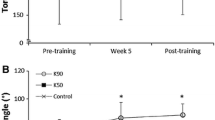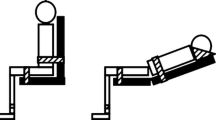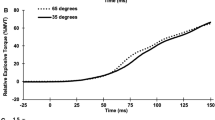Abstract
Triceps surae function can be modified by changes in knee joint angle through altering the effective contribution of the bi-articular gastrocnemeii. However, the impact on plantar flexor power from altering knee angle has not been studied systematically across a range of loads. Here, in 11 young men (25.7 ± 2.2 years), we determine the effect of knee angle on torque, velocity and power at loads ranging from 15 to 75 % maximal voluntary isometric contraction (MVC). Contractile properties were recorded with either the knee extended (170º) or flexed (90º). Despite similar voluntary activation (~97 %), peak twitch and MVC torques were 25 and 16 % lower in the flexed than extended knee (P < 0.05), respectively. Across all loads, subjects were 15–24 % less powerful with the knee flexed than extended (P < 0.05). In the flexed knee at relative loads ≤30 % MVC, impaired power was accompanied by 6–9 % slower shortening velocities than the extended knee. However, for the higher loads, limited torque production in the flexed knee was the key factor contributing to the generation of maximal power than for the extended position. This was supported by no change in velocity at higher loads (>30 % MVC) and a 15–22 % lower maximal rate of torque development across all loads. Hence, in a flexed knee position, which disadvantages the contribution of the gastrocnemeii, results in a left-downward shift in the torque–power relationship impairing maximal power production. Thus, the gastrocnemeii are not only a major contributor to plantar flexion torque, but also critical for modifying loaded shortening velocity and ultimately power production.




Similar content being viewed by others
Abbreviations
- HRT:
-
Half relaxation time of twitch
- MRTD:
-
Maximal rate of torque development
- MVC:
-
Maximal voluntary isometric contraction
- SD:
-
Standard deviation
- SEM:
-
Standard error of the mean
- T–V:
-
Torque–velocity
- TPT:
-
Time to peak twitch torque
References
Andersen LL, Aagaard P (2006) Influence of maximal muscle strength and intrinsic muscle contractile properties on contractile rate of force development. Eur J Appl Physiol 96:46–52
Arampatzis A, Karamanidis K, Stafilidis S, Morey-Klapsing G, DeMonte G, Bruggemann GP (2006) Effect of different ankle- and knee-joint positions on gastrocnemius medialis fascicle length and EMG activity during isometric plantar flexion. J Biomech 39:1891–1902
Bobbert MF, van Ingen Shenau GJ (1990) Isokinetic plantar flexion: experimental results and model calculations. J Biomech 23:105–119
Bottinelli R, Schiaffino S, Reggiani C (1991) Force–velocity relations and myosin heavy chain isoform compositions of skinned fibres from rat skeletal muscle. J Physiol 437:655–672
Brown IE, Scott SH, Loeb GE (1996) Mechanics of feline soleus: II design and validation of a mathematical model. J Muscle Res Cell Motil 17:207–219
Carpentier A, Duchateau J, Hainaut K (1996) Velocity-dependent muscle strategy during plantarflexion in humans. J Electromyogr Kinesiol 6:225–233
Carpentier A, Duchateau J, Hainaut K (1999) Load-dependent muscle strategy during plantarflexion in humans. J Electromyogr Kinesiol 9:1–11
Cormie P, McGuigan MR, Newton RU (2011) Developing maximal neuromuscular power: part 1-biological basis of maximal power production. Sports Med 41:17–38
Cresswell AG, Löscher WN, Thorstensson A (1995) Influence of gastrocnemius muscle length on triceps surae torque development and electromyographic activity in man. Exp Brain Res 105:283–290
Dalton BH, Power GA, Vandervoort AA, Rice CL (2010) Power loss is greater in old men than young men during fast plantar flexion contractions. J Appl Physiol 109:1441–1447
Dalton BH, Power GA, Vandervoort AA, Rice CL (2012) The age-related slowing of voluntary shortening velocity exacerbates power loss during repeated fast knee extensions. Exp Gerontol 47:85–92
Faulkner JA, Claflin DR, McCully KK, Jones DA (1982) Contractile properties of bundles of fiber segments from skeletal muscles. Am J Physiol 243:C66–C73
Fitts RH, Widrick JJ (1996) Muscle mechanics: adaptations with exercise-training. Exerc Sport Sci Rev 24:427–473
Fugl-Meyer AR, Sjöström M, Wählby L (1979) Human plantar flexion strength and structure. Acta Physiol Scand 107:47–56
Fukunaga T, Roy RR, Shellock FG et al (1992) Physiological cross-sectional area of human leg muscles based on magnetic resonance imaging. J Orthop Res 10:928–934
Herzog W, Read LJ, ter Keurs HEDJ (1991) Experimental determination of force–length relations of intact human gastrocnemius muscles. Clin Biomech 6:230–238
Johnson MA, Polgar J, Weightman D, Appleton D (1973) Data on the distribution of fibre types in thirty-six human muscles. An autopsy study. J Neurol Sci 18:111–129
Joseph J, Nightingale A (1952) Electromyography of muscles of posture: leg muscles in males. J Physiol 117:484–491
Kawakami Y, Ichinose Y, Fukunaga T (1998) Architectural and functional features of human triceps surae muscles during contraction. J Appl Physiol 85:398–404
Kawakami Y, Muraoka T, Ito S, Kanehisa H, Fukunaga T (2002) In vivo muscle fibre behaviour during counter-movement exercise in humans reveals a significant role for tendon elasticity. J Physiol 540:635–646
Kennedy PM, Cresswell AG (2001) The effect of muscle length on motor-unit recruitment during isometric plantar flexion in humans. Exp Brain Res 137:58–64
Lieber RL, Ward SR (2011) Skeletal muscle design to meet functional demands. Philos Trans R Soc Lond B Biol Sci 366:1466–1476
Lionikas A, Li M, Larsson L (2006) Human skeletal muscle myosin function at physiological and non-physiological temperatures. Acta Physiol 186:151–158
Murray MP, Guten GN, Baldwin JM, Gardner GM (1976) A comparison of plantar flexion torque with and without the triceps surae. Acta Orthop Scand 47:122–124
Nishimura Y, Nakajima Y (2002) Effect of muscle length on the recruitment property of single motor units in humans. Neurosci Lett 332:49–52
Podolin RA, Ford LE (1986) Influence of partial activation on force-velocity properties of frog skinned muscle fibers in millimolar magnesium ion. J Gen Physiol 87:607–631
Power GA, Dalton BH, Rice CL, Vandervoort AA (2010) Delayed recovery of velocity-dependent power loss following eccentric actions of the ankle dorsiflexors. J Appl Physiol 109:669–676
Power GA, Dalton BH, Rice CL, Vandervoort AA (2011) Reproducibility of velocity-dependent power: before and after lengthening contractions. Appl Physiol Nutr Metab 36:626–633
Sale D, Quinlan J, Marsh E, McComas AJ, Belanger AY (1982) Influence of joint position on ankle plantarflexion in humans. J Appl Physiol 52:1636–1642
Svantesson U, Ernstoff B, Bergh P, Grimby G (1991) Use of a Kin-Com dynamometer to study the stretch-shortening cycle during plantar flexion. Eur J Appl Physiol Occup Physiol 62:415–419
Todd G, Gorman RB, Gandevia SC (2004) Measurement and reproducibility of strength and voluntary activation of lower-limb muscles. Muscle Nerve 29:834–842
Trappe SW, Trappe TA, Lee GA, Costill DL (2001) Calf muscle strength in humans. Int J Sports Med 22:186–191
Trappe S, Gallagher P, Harber M, Carrithers J, Fluckey J, Trappe T (2003) Single muscle fibre contractile properties in young and old men and women. J Physiol 552:47–58
Tucker KJ, Tuncer M, Turker KS (2005) A review of the H-reflex and M-wave in the human triceps surae. Hum Mov Sci 24:667–688
Wakahara T, Kanehisa H, Kawakami Y, Fukunaga T (2007) Fascicle behavior of medial gastrocnemius muscle in extended and flexed knee positions. J Biomech 40:2291–2298
Ward SR, Eng CM, Smallwood LH, Lieber RL (2009) Are current measurements of lower extremity muscle architecture accurate? Clin Orthop Relat Res 467:1074–1082
Widrick JJ, Norenberg KM, Romatowski JG et al (1998) Force-velocity-power and force-pCa relationships of human soleus fibers after 17 days of bed rest. J Appl Physiol 85:1949–1956
Acknowledgments
We would like to thank all those who participated in the experiments. This work was supported by the Natural Sciences and Engineering Research Council of Canada. Brian H Dalton is now a postdoctoral fellow at the University of British Columbia and supported by the Michael Smith Foundation for Health Research and the Canadian Institutes of Health Research.
Ethical standards
The experiments comply with the current laws of the country in which they were performed.
Conflict of interest
The authors declare they have no conflict of interest.
Author information
Authors and Affiliations
Corresponding author
Additional information
Communicated by Alain Martin.
Rights and permissions
About this article
Cite this article
Dalton, B.H., Power, G.A., Allen, M.D. et al. The genu effect on plantar flexor power. Eur J Appl Physiol 113, 1431–1439 (2013). https://doi.org/10.1007/s00421-012-2560-0
Received:
Accepted:
Published:
Issue Date:
DOI: https://doi.org/10.1007/s00421-012-2560-0




